| Author |
Merit Badge Chit Chat:  Music Merit Badge Music Merit Badge  |
|
|
Ginger Dawn
True Blue Farmgirl
  
99 Posts
Ginger
Inwood
WV
USA
99 Posts |
 Posted - Jan 06 2017 : 03:08:30 AM Posted - Jan 06 2017 : 03:08:30 AM

|
Last year my son joined the High School band. I admit that at first, I was totally against it. Band is a huge commitment and I was not sure if it would work with other activities that my son is involved in. However, after much thought and discussion as a family we made the decision to embrace the opportunity.
My husband and I both have no musical background. We don’t know how to read music and thought, “Hey, this will be an opportunity for us too. Therefore, we decided to take music lesson from our Son’s private instructor. Sam Jannotta from Shepherdstown School of Music. The adventure began! We first leans some of the basic terms such as rhythm, melody, and harmony.
Rhythm is the element of "TIME" in music. When you tap your foot to the music, you are "keeping the beat" or following the structural rhythmic pulse of the music. There are several important aspects of rhythm:
DURATION: how long a sound (or silence) lasts.
TEMPO: the speed of the BEAT.
(Note: Tempo indications are often designated by Italian terms):
Largo = "large" or labored (slow)
Adagio = slow
Andante = steady "walking" tempo
Moderato = moderate
Allegro = fast ("happy")
Presto = very fast
METER: Beats organized into recognizable/recurring accent patterns. Meter can be seen/felt through the standard patterns used by conductors.
Melody is the LINEAR/HORIZONTAL presentation of pitch
(the word used to describe the highness or lowness of a musical sound). Many famous musical compositions have a memorable
Melody or theme.
THEME: a melody that is the basis for an extended musical work
Melodies can be derived from various scales (families of pitches) such as the traditional major and minor scales of tonal music, to more unusual ones such as the old church modes (of the Medieval and Renaissance periods: c. 500–1600), the chromatic scale and the whole tone scale (both used in popular and art-music styles of the late 19th and 20th-century periods), or unique scale systems devised in other cultures around the world.
Melodies can be described as:
• CONJUNCT (smooth; easy to sing or play)
• DISJUNCT (disjointedly ragged or jumpy; difficult to sing or play).
Harmony is the VERTICALIZATION of pitch. Often, harmony is thought of as the art of combining pitches into chords (several notes played simultaneously as a "block"). These chords are usually arranged into sentence-like patterns called chord progressions.
All these terms above were taught to me and explained in a great book titled, “Elements of Music” It is a very good book and I noticed that this book is very popular in the schools. My next task was what sorta genera or music do I want to play on the piano. I listened to several different styles but decided on learning some classical, Jazz, and a seasonal song. I am going to keep this part as a surprise because I plan on making a video of this in an upcoming blog post. Yes, Me on piano, hubby on guitar, and my son on Sax. It really felt great to be able to learn a bit more about music and pick out the different elements. Even better to do something together as a family!
Oh and I rather enjoy being a Band Mom! I encourage everyone to try something new and even if it is a way to understand your child's passion. |
|
|
Ginger Dawn
True Blue Farmgirl
  
99 Posts
Ginger
Inwood
WV
USA
99 Posts |
 Posted - Jan 06 2017 : 04:22:49 AM Posted - Jan 06 2017 : 04:22:49 AM

|
So what does a gal do when there is snow outside and a two hour school delay? Finish up my Music Intermediate Merit badge! I would practice my piano but no need to wake up the guys too early. However, I just want you sisters to know that music can bring pleasure even when you are reading about those who created wonderful songs for all to enjoy. This is what I have learned over the last three days on one classical composer and one musician/composer from the last 100 years.
I chose Ludwig van Beethoven. Hey can you blame me! He is from the Romantic Era and well everyone knows what a huge heart I have. Composer Ludwig van Beethoven was baptized on December 17, 1770, in Bonn, Germany. He was an innovator, widening the scope of sonata, symphony, concerto and quartet, and combining vocals and instruments in a new way. His personal life was marked by a struggle against deafness, and some of his most important works were composed during the last 10 years of his life, when he was quite unable to hear. He died in 1827 at the age of 56.
It is rather easy to find information on the internet about Beethoven. Beethoven never married or had children. He was, however, desperately in love with a married woman named Antonie Brentano. Over the course of two days in July of 1812, Beethoven wrote her a long and beautiful love letter that he never sent. Addressed "to you, my Immortal Beloved," the letter said in part, "My heart is full of so many things to say to you -- ah -- there are moments when I feel that speech amounts to nothing at all -- Cheer up -- remain my true, my only love, my all as I am yours."
The death of Beethoven's brother Caspar in 1815 sparked one of the great trials of his life, a painful legal battle with his sister-in-law, Johanna, over the custody of Karl van Beethoven, his nephew and her son. The struggle stretched on for seven years during which both sides spewed ugly defamations at the other. In the end, Beethoven won the boy's custody, though hardly his affection. Biography.com gives more details about the above and his Short-tempered, absent-minded, greedy and suspicious behavior. Nevertheless, Beethoven had extraordinary talent and the fortitude to overcome personal trials. Ludwig van Beethoven is widely considered the greatest composer of all time. He is the crucial transitional figure connecting the Classical and Romantic ages of Western music.
For a modern composer, I chose David Lang. He grew up in Los Angeles in the ’60s, in a family of upwardly mobile, education-oriented intellectual Jewish immigrants. His father was a doctor whose parents had come from Lithuania, his mother a librarian, born in Germany. Their cultural tastes veered toward art, literature, sports—Lang’s dad taught him to keep score at Dodgers games—but not music. One rainy afternoon when Lang was in elementary school, instead of playing in the yard, his class watched a Leonard Bernstein “Young People’s Concert” featuring Shostakovich’s First Symphony. To introduce the piece, Bernstein explained that Shostakovich wrote it when he was 19 and instantly became world famous. The music enthralled Lang. He was 9, and his first thought, he said, was: “I have 10 years.”
Much like Beethoven he creates from a very emotion foundation within his soul. This passion began at a young age. “Lang is one of America's most performed composers. Many of his works resemble each other only in the fierce intelligence and clarity of vision that inform their structures. His catalogue is extensive, and his opera, orchestra, chamber and solo works are by turns ominous, ethereal, urgent, hypnotic, unsettling and very emotionally direct.” I have several cds by David Land and the above statement by biography.com is very true. The New Yorker states, “With his winning of the Pulitzer Prize for the little match girl passion (one of the most original and moving scores of recent years), Lang, once a postminimalist enfant terrible, has solidified his standing as an American master.”
I find it almost impossible to write how both composers are similar except that they both were passionate about music, highly educated, and were very private about their personal life. Some refer to Beethoven as shy but some say he like Lang have an introverted personality. Personally, I see nothing wrong with this. So much is constantly published in the media that it is hard to know what is or isn’t true. I can understand why Land keeps his personal life private.
I have always had a passion for learning and I find that music is not only a way to connect but creates an amazing feeling inside.
|
 |
|
|
MaryJane
Queen Bee
    
16783 Posts

MaryJane
Moscow
Idaho
USA
16783 Posts |
 Posted - Jan 06 2017 : 09:21:43 AM Posted - Jan 06 2017 : 09:21:43 AM

|
So loved reading this Ginger. Made my day!
MaryJane, Farmgirl #1 Plowin' Thru ~ giving aprons a good wrap for 45 years and counting ~
 |
 |
|
|
farmgirl68
True Blue Farmgirl
   
369 Posts
Katie
Bangor
Pennsylvania
USA
369 Posts |
 Posted - Jul 12 2017 : 08:25:34 AM Posted - Jul 12 2017 : 08:25:34 AM

|
I will be working on my music merit badge as well. I have a degree in music but I look forward to re-examining the basic elements and genres from the perspective of someone with a little more experience than when I was in college.
I will be attending an interesting concert on Saturday featuring Briga
"Briga's music is best described as a Balkan/Quebecois mash-up of music, delivered with a turbo folk edge, wrapped up in heavy grooves that drive her wailing violin and sweet voice. Sometimes instrumental, sometimes in French, Briga's sound encompasses European and Romani folk that is exciting and exotic. With a sweet voice that contrasts the violin, accordion and myriad of percussion instruments, Briga's music often vacillates between slow and fast paced beats.
I have a degree in violin performance but I was very classically trained. I have utmost respect for violinist who can improvise and I look forward to hearing her music. It sounds so interesting!
KTBug
Friends are the flowers that bloom in life's garden. |
 |
|
|
farmgirl68
True Blue Farmgirl
   
369 Posts
Katie
Bangor
Pennsylvania
USA
369 Posts |
 Posted - Jul 13 2017 : 06:01:48 AM Posted - Jul 13 2017 : 06:01:48 AM

|
Well I worked and I worked and listened and listed. I had a great time. What a throw back to my college days! I hope I'm doing this right, this is my first attempt at a merit badge.
I found two very good websites that helped me considerably. The dictionary website has musical clips that you can listen to that really drives home, not just in words, but "hearing" the definition which when it comes to music I think is even more important.
https://dictionary.onmusic.org, http://www.musicgenreslist.com/
I. Learn about three of the basic elements of music: rhythm, melody, and harmony
“Rhythm – Rhythm is the subdivision of a space of time into a defined, repeated pattern. Rhythm is the controlled movement of music in time. It may be defined as the division of music into regular metric portions; the regular pulsation of music. https://dictionary.onmusic.org/terms/2896-rhythm The speed of the rhythm of a composition is called tempo.” https://dictionary.onmusic.org/terms/3493-tempo
Rhythm is controlled by the score, the instrumentation, the conductor (if there is one) or leader.
I listened to the following: Arcangelo Corelli: Violin Sonata in A major, Op. 5, No. 9, "Gigue"; Claude Debussy: Syrinx for Flute Solo; Frédéric Chopin: Prelude in E minor, Op.28 No. 4; Franz Schubert: Gretchen am Spinnrade, D. 118; François Couperin: Second livre de clavecin, "Les barricades misterieuses" ; Johann Sebastian Bach: Brandenburg Concerto No. 6 in B-flat major, BWV 1051, III; "Ríu, ríu, chíu"
“Melody – Melody is a tune; a succession of tones comprised of mode, rhythm, and pitches so arranged as to achieve musical shape, being perceived as a unity by the mind. In a piece of music where there is more than one voice, or where harmony is present, the melody is the dominant tune of the composition.” https://dictionary.onmusic.org/terms/2138-melody
I think of melody as what you would sing to yourself when you’re thinking of a particular selection. For instance, when I think of Dvorak’s New World Symphony one of the melodies that comes to mind is the “jaws theme”.
I listened to the following: George Frideric Handel: Samson, "Let the Bright Seraphim"; Joseph Haydn: Concerto for Trumpet in E-flat major; Wolfgang Amadeus Mozart: The Magic Flute, Act II, "Oh Isis and Osiris"; Richard Strauss: Don Juan, Op. 2; Johann Sebastian Bach: Brandenburg Concerto No. 6 in B-flat major, BWV 1051, III; Richard Wagner: Tristan und Isolde; Johann Sebastian Bach: The Art of the Fugue, BWV 1080 Contrapunctus I; Mass in Gregorian chant: Gregorian Chant:: "Alleluia: Dies sanctificatus"; Berenguier de Palou: "Tant m'abelis" Music of the Troubadours (Ensemble Unicorn); Claude Debussy: Préludes, Book I, "La cathédrale engloutie"; Johann Sebastian Bach: Concerto for Violin and Oboe in C minor, BWV 1060; Gustav Holst: The Planets, Op. 32, "Jupiter, The Bringer of Jollity"; Wolfgang Amadeus Mozart: Piano Concerto No. 21 in C major, K. 467, II; Johann Sebastian Bach: Concerto for Violin and Oboe in C minor, BWV 1060, II; Maurice Ravel: "Boléro"
“Harmony – 1. Harmony is the combination of notes sounded simultaneously to produce chords. Usually, this term is used to describe consonance, however, it can also be used to describe dissonance. 2. Harmony can also be described as the countermelodic notes to accompany a tune.” https://dictionary.onmusic.org/terms/1673-harmony
Harmony makes a piece interesting. It adds suspense, drama, and can help the melody actually stand out. As a violinist I used to love playing harmony because it made you think a little more, you were never quite sure where the composer may take you. It also, often, was more difficult because of these same facts.
I listened to the following: Henry Purcell: Come, ye Sons of Art, come away, "Chaconne"; Johann Sebastian Bach: Cantata No. 140, Wachet auf, BWV 140, "Er kommt, er kommt"; Johann Sebastian Bach: Chromatic Fantasia and Fugue in D minor; Wolfgang Amadeus Mozart: Piano Concerto No. 21 in C major, K. 467, II; Joseph Haydn: The Creation, "Achieved is the glorious work"; Maurice Ravel: Daphnis et Chloé; Guillaume Machaut: Songs from Le Voir Dit: Ballade 32: Plourez dames; Organum: Viderunt omnes; Richard Wagner: Tristan und Isolde, Prelude; Johannes Brahms: Violin Concerto in D major, Op. 77, III; Frédéric Chopin: Prelude in E minor, Op. 28, No. 4; Franz Schubert: Gretchen am Spinnrade, D. 118; Arnold Schoenberg: Suite for Piano, Op. 25, I; Philip Glass: Bible (Old Testament) "Psalm 126"; Ludwig van Beethoven: Serenade in D major, Op. 8, I; Sergei Prokofiev: Classical Symphony, III; Giovanni Pierluigi Palestrina: Missa in Festis Apostolorum I, "Agnus Dei"
II. Listen to three songs from three different genres of music and identify the elements in each.
http://www.musicgenreslist.com/
Genre 1: Neoclassical
Work: Symphony No. 1 in D major, Sergei Prokofiev
Rhythm:
The symphony is made up of 4 movements which clearly define the tempos.
I. Allegro (a fast tempo often used for a first and/or last movement)
II. Larghetto (not as slow as largo it is between 60 – 66 beats per minute)
III. Gavotta: Non troppo allegro (a Gavotte is a dance usually written in cut time, non troppo allegro would be not too fast)
IV. Finale: Molto vivace (very brisk tempo)
Melody and Harmony:
This symphony is scored for a typical classical period (think Hayden) orchestra: strings, 2 flutes, 2 oboes, 2 clarinets, 2 bassoons, 2 horns, 2 trumpets, and timpani. There are also parts for 3 trombones and a tuba that can be used but are not necessary to the melody and harmony.
The scoring is important to how the melody and harmony play out in the symphony. The melody is usually played by one instrument at a time while the others play harmony but the melody moves about the orchestra throughout within each of the movements. No group of instruments gets left out. It adds interest and ends up being beautiful. Although written in a classical bent, there is no escaping Prokofiev’s remarkable harmonies where dissonance quickly resolves. I’ve always been in awe of his composing. His pieces, I will tell you, are not the easiest to play!
Genre 2: Jazz/Blues
Work: "Fine and Mellow", Billie Holiday first recorded April 20, 1939
Rhthym:
As I mention below, the 12-bar blues chord progression is also distinctive in its duration, the rhthym. The snare and percussion keeps a constant beat throughout this iconic piece.
The term 12-bar refers to the number of measures that expresses the theme. Almost all blue is played to a 4/4 time signature where the quarter note gets the beat and there are 4 beats in every measure.
Melody and Harmony:
This song is based on what is called the 12-bar blues. This is a chord progression which is very popular, still, in popular music. It is based on the I, IV, and V chords which is how back up musicians can follow the soloist who is improvising. It is also very characteristic in its phrasing and duration.
In order of solos from a 1957 TV special performed by Billie Holiday (the first six are listed in the order of their solos):
Ben Webster, tenor saxophone; Lester Young, tenor saxophone; Vic Dickenson, trombone; Gerry Mulligan, baritone saxophone; Coleman Hawkins, tenor saxophone; Roy Eldridge, trumpet; Doc Cheatham, trumpet; Danny Barker, guitar; Milt Hinton, double bass; Mal Waldron, piano; Osie Johnson, drums
In jazz and blues the melody is often “taken” over in solo performances where the performer will take the melody line and improvise while the other instruments provide a percussive swagger and harmony.
Most often in the lyrics in a 12-bar blues, the 1st and 2nd lines are repeated and the 3rd line is a response.
You can see this repeat and response in the lyrics of “Fine and Mellow”
Genre 3. World/Celtic
(a) Marino Casino (b) Gerry Cronin's Reel (c) Denis Langton's Reel (d) Irish Washerwoman
Rhythm: The rhythm changes based on the dance being played. I will concentrate on the reels and the jig. Based on a duple meter and the Irish Washerwoman in 6/8 (I know this mainly because I remember playing it as a child). The timing of both lively dances is emphasized by a heavy downbeat where the eighth note gets the beat and there are 6 eighth notes to a meter.
Melody/Harmony: The melody in reels and jigs is a tune that has multiple verses and is repeated often with subtle variations made by the performer. In this case the fiddle and flute played the melody and the guitar played chord progressions that seemed very similar to that of the 12-bar blues although I cannot be sure.
So, did I do ok?
KTBug
Friends are the flowers that bloom in life's garden. |
 |
|
|
farmgirl68
True Blue Farmgirl
   
369 Posts
Katie
Bangor
Pennsylvania
USA
369 Posts |
 Posted - Jul 14 2017 : 07:20:29 AM Posted - Jul 14 2017 : 07:20:29 AM

|
So I began my intermediate level and decided to do research on Aaron Copland for my composer. I always loved to play his pieces and I never researched him before. I found him absolutely fascinating! Oh, and I went to the library for the first time in years. I felt out of my element but it was wonderful at the same time. Here is what I found...
Aaron Copland – Composer, Conductor, Performer, Teacher, Author, Activist
Demographics
Birth – November 14, 1900, Brooklyn, NY
His parents were Jewish immigrants from Russia, Harris Morris Copland and Sarah Mittenthal Copland. Aaron was one of five children.
Death – December 2, 1990, North Tarrytown, NY
Education
Copland never formally went to a college or conservatory. Instead he studied under many esteemed private instructors while receiving his base education Boys High School. He benefited from studying in Manhattan because he was able to take advantage of the rich arts world. He attended concerts and met composers and performers. He did go to the American Conservatory in Fontainebleau France for one year and then spent another two years in France, again studying privately under many instructors. Having had such a variety of instruction may account for some of the variety in his music.
The Man
After WWI, he joined many other Americans at Montparnasse Paris. Writers, musicians, artists such as Ezra Pound, E.E. Cummings, Ernest Hemmingway, Sinclair Lewis, and Alexander Calder and Stuart Davies to name a few.
There he was free from the constraints of his formal education. Many of his former teachers were very strict about composition and he was not able to create his own style. Montparnasse was a “Bohemian” style area where the artists were free from restrictions and were able to find their own identities. Copland actually set the poetry of Cummings and Pound to music during this time. Although he found comradery, Copland felt singled out because of his homosexuality and Jewish background. Few of his friendship during this time lasted long.
In 1924 Copland returned to New York where he was most comfortable. He would travel abroad from time to time for study or performance but he always returned to his home – New York.
While he performed, conducted, taught composition, wrote, and composed, Copland was also instrumental to the rights of musicians and composers. He was a part of what would become Arrow Music Press, a Composers’ Protection Society and the American Composers Alliance (ACA), based largely on similar benefits to those of ASCAP for popular music composers.
Some of His Major Works
Piano Variations (1930), The Dance Symphony (1930), El Salon Mexico (1935), Of Mice and Men (1939), Our Town (1940), The North Star (1943), A Lincoln Portrait (1942), Fanfare for the Common Man (1942), Appalachian Spring (1944), The Heiress (1949), Variations on a Shaker Melody (1967)
Awards
1945 – Pulitzer Prize for Music – Appalachian Spring
1949 – Oscar – The Heiress
Authored Books
What to Listen for in Music (1939), Our New Music (1941), Music and Imagination (1952), and an autobiography co-authored with Vivian Perlis Copland: 1900 through 1942 (1984)
Sources
Print:
Chase, Gilbert. America's Music: From the Pilgrims to the Present. 2nd ed. Urbana: U of Illinois, 1992. Print.
Copland, Aaron and Vivian Perlis, Copland 1900 through 1942. New York: St. Martin’s, 1984. Print
Pollack, Howard. Aaron Copland: The Life and Work of an Uncommon Man. New York: Henry Holt, 1999. Print
Web:
Biography.com Editors. “Aaron Copland.” Biography.com. A&E Networks Television, 29 Dec. 2015. Web. 14 July 2017.

Katie #7422
Friends are the flowers that bloom in life's garden. |
 |
|
|
Ginger Dawn
True Blue Farmgirl
  
99 Posts
Ginger
Inwood
WV
USA
99 Posts |
 Posted - Jul 14 2017 : 7:14:41 PM Posted - Jul 14 2017 : 7:14:41 PM

|
Katie!
Very well done and I so appreciate the amount of information that you shared. I even looked up some of his music on YouTube. Thank you so much for sharing!
I would love to have been a fly on the wall when he met with C.S. Lewis and others!
Great job Farmgirl Sister!!! |
 |
|
|
farmgirl68
True Blue Farmgirl
   
369 Posts
Katie
Bangor
Pennsylvania
USA
369 Posts |
 Posted - Jul 15 2017 : 07:01:48 AM Posted - Jul 15 2017 : 07:01:48 AM

|
Thank you for the feedback! I will be posting about my musician (Itzhak Perlman) along with the compare contrast today. I'm having so much fun doing this!
Katie #7422
Friends are the flowers that bloom in life's garden. |
 |
|
|
farmgirl68
True Blue Farmgirl
   
369 Posts
Katie
Bangor
Pennsylvania
USA
369 Posts |
 Posted - Jul 15 2017 : 08:04:49 AM Posted - Jul 15 2017 : 08:04:49 AM

|
Itzhak Perlman – Violinist, Composer, Conductor, Teacher, Philanthropist
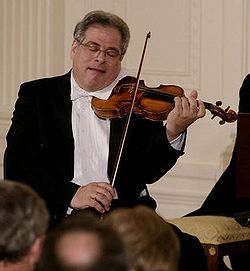
Demographics
Born: August 31, 1945, Tel Aviv, Israel. When he was 4 years old, he developed polio and his legs became permanently paralyzed. Perlman’s parents immigrated to Palestine in the mid-1930’s from Poland. His early life was poor; however, he pursued his life in music despite his medical and financial obstacles. He is married to Toby who is also a violinist and lives in New York City. They have five children. Perlman is a distant cousin of comic Howie Mandel.
Education
1st Violin – Age 3 from a thrift store which he taught himself on until he was allowed access to the Shulamit Conservatory which he was denied at first (at the age of three) because he was told he was too small to hold a violin. He continued to play even after developing polio working even harder to overcome some of the obstacles. When he was finally accepted he studied under Rivka Goldgart and gave his first recital when he was 10 years old. He then moved to the United States and studied under Ivan Galamian and Dorothy DeLay at the Julliard School.
Honorary Degrees – Yale, Harvard, Brandeis Universities and the Hebrew University in Jerusalem, Israel
The Man
When Itzhak was 13, he was brought to the United States to represent Israel in the Caravan of the Stars during its tour of the U.S. which happened to be on the Ed Sullivan show. After this, Perlman and his mother moved to New York, joined later by his father a year later.
His family struggled and young Itzhak was dependent on the generosity of many. This, along with his Jewish background, help shape the generous man he is today.
From what I have read, Itzhak is all about the music and helping others. His particular interests are helping disabled musicians from Israel see out their dreams just as he did. I remember watching him on Sesame Street over 40 years ago. I think he was talking with Grover and he was explaining what a violin was and he was playing his sweet sounds. He also explained why he couldn’t walk and a little about polio. I, at that point, had already been playing violin for a number of years; but I never stopped respecting this man who overcame so many obstacles to pursue his dreams. Even though I played at two years of age (I had a 64th size violin) and I had the talent, I never had that extra spark that he must have had.
Some of His Major Works/Performances
This man never shuts down!! He has performed with EVERY major orchestra in the United States and many abroad. Here are just some of his highlights:
1958, 1964 – The Ed Sullivan Show, 1963 – Carnegie Hall Debut, Sesame Street (This is where I was introduced to him and fell in love with him), 1986 – New York Philharmonic’s tribute to the 100th Anniversary of the Statue of Liberty, 1989 – violin solo, The Downeaster Alexa with Billy Joel (uncredited), 1993 – Schindler’s List written by John Williams, 2005 – Memoirs of a Geisha, 2007 – State Dinner in attendance by Queen Elizabeth II in the East Room at the White House, 2009 – Barack Obama Inauguration Ceremony
Lesser known works include Perlman singing and playing jazz.
http://www.ranker.com/list/best-itzhak-perlman-albums-list/reference
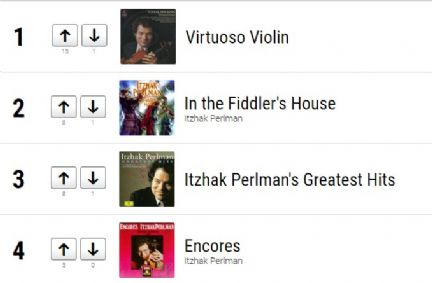
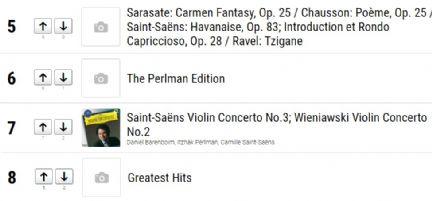
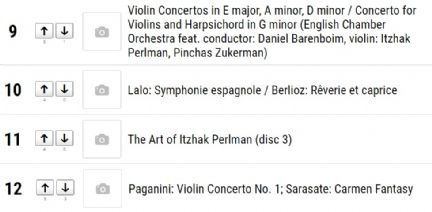
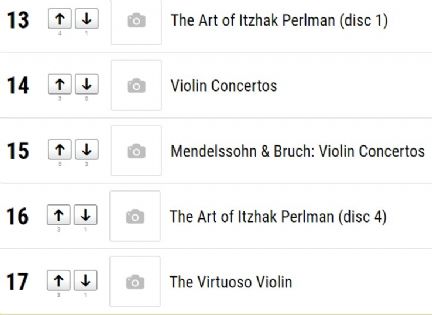 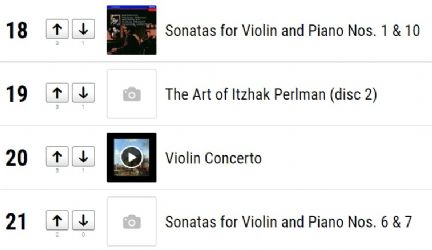 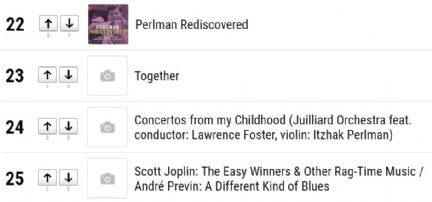
If you haven’t heard the soundtrack to Schindler’s List and want to hear a little of Perlman’s sweet sounds, I highly recommend starting with this.
Awards
15 Grammy Awards
Medal of Liberty by President Reagan (1986)
4 Emmy Awards
National Medal of Arts by President Clinton (2000)
Grammy Lifetime Achievement Award (2008)
Presidential Medal of Freedom by President Obama (2015)
Genesis Prize by Prime Minister of Israel (2016)
As well as many other honors
Endowments (Philanthrophy)
Tzedaka – Jewish term for giving back
Itzhak had to take advantage as a young man of the gracious gifts of many. As a world-wide success, Perlman applies tzedaka as part of his human spirit!
“Asked what he would speak about in his address at the Genesis Prize Ceremony in Jerusalem on Thursday night, Perlman said: ‘My message is that giving is very important. Giving is a Jewish thing, and I like to talk about that. There’s nothing more important, personally, for anybody than being able to give. That’s what I feel, and that’s what I’m going to talk about.’
This speech was given after being awarded the 2016 Genesis Prize which included a million dollar prize.
The Perlman music program, founded in 1995 by Toby Perlman and Suki Sandler
Sources
Web:
Biography.com Editors. "Itzhak Perlman." Biography.com. A&E Networks Television, 22 Nov. 2015. Web. 14 July 2017.
“The Official Website of Violnist Itzhak Perlman.” Itzhak Perlman. N.p., n.d. Web. 14 July 2017.
Linde, Steve. “Giving Is a Jewish Thing, “Itzhak Perlman Tells Post’.” The Jerusalem Post/JPost.com. N.p., 21 June 2016. Web 14 July 2017.
Katie #7422
Friends are the flowers that bloom in life's garden. |
 |
|
|
farmgirl68
True Blue Farmgirl
   
369 Posts
Katie
Bangor
Pennsylvania
USA
369 Posts |
 Posted - Jul 15 2017 : 09:46:16 AM Posted - Jul 15 2017 : 09:46:16 AM

|
Compare and Contrast Copland to Perlman
Similarities:
They are both Jewish.
They both grew up and studied most of their life in New York.
They conducted, performed, and taught. (Perlman still does today)
Differences:
While they are both Jewish, Copland felt as though being Jewish was a hindrance while Perlman embraces his background.
Perlman is married with children and Copland had many homosexual partners. Because of when he was alive being homosexual was not an open lifestyle, Copland never felt at ease with his personal life. Maybe if he were alive today he would be more comfortable and able to live more at peace.
Perlman grew up poor and had to accept the money of many different gracious contributors. He never forgot this and has paid it forward ever since. Copland grew up comfortable and to my knowledge did not set up endowments or gifts.
Copland was active in politics and programs to protect composers while Perlman is more active in arts programs.
Katie #7422
Friends are the flowers that bloom in life's garden. |
 |
|
|
farmgirl68
True Blue Farmgirl
   
369 Posts
Katie
Bangor
Pennsylvania
USA
369 Posts |
 Posted - Jul 15 2017 : 10:02:28 AM Posted - Jul 15 2017 : 10:02:28 AM

|
Ginger, I have Lang playing in the background today. Thank you for re-introducing me to his works and for the information about him!
Katie #7422
Friends are the flowers that bloom in life's garden. |
 |
|
|
Ginger Dawn
True Blue Farmgirl
  
99 Posts
Ginger
Inwood
WV
USA
99 Posts |
 Posted - Jul 15 2017 : 10:40:47 AM Posted - Jul 15 2017 : 10:40:47 AM

|
| Wow! Farmgirl, you gave gone above and beyond. I love violin and what great music for weeding the garden. I honestly think the bugs liked it too. Good garden bugs that is...lol I also like how you wrote the similarities and differences. I will use that next time I compare. The breaks make it easier to read. I must say, isn't it great to learn new things! |
 |
|
| |
Merit Badge Chit Chat:  Music Merit Badge Music Merit Badge  |
|
|
|